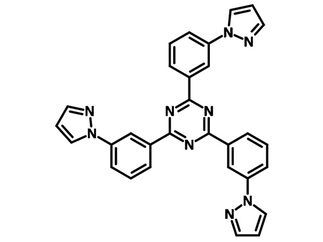3P-T2T
CAS Number 352196-01-1
High Purity Sublimed Materials, Host Materials, Materials, OLED Materials, Semiconducting Molecules, TADF Host Materials,3P-T2T, ETL material for OLED devices
Highly efficient blue as well as green, yellow and host for red phosphorescent emitter, 2,4,6-tris(2-(1H-pyrazol-1-yl)phenyl)-1,3,5-triazine (3P-T2T), CAS 352196-01-1
3P-T2T, 2,4,6-tris(2-(1H-pyrazol-1-yl)phenyl)-1,3,5-triazine, has a structure with an electron deficient triazine core equipped with phenylpyrazole peripherals. Like PO-T2T and 3N-T2T, 3P-T2T is one of the triazine derivatives and is normally used as an electron transport layer (ETL) in OLED devices. 3P-T2T shows a higher electron transport/injection ability than T2T due to the peripheral three electron-withdrawing pyrazolyl moieties.
As an acceptor, together with TCTA as hole transporting donor, 3P-T2T forms exciplex as a highly efficient yellow delayed fluorescent emitter. The exciplex TCTA:3PT2T has high and balanced hole and electron mobilities and large energy-levels offsets at the TCTA/3P-T2T interface.
3P-T2T can not only accommodate highly efficient blue, but can also act as suitable host for green, yellow and red phosphorescent emitters.
General Information
| CAS number | 352196-01-1 |
|---|---|
| Chemical formula | C30H21N9 |
| Molecular weight | 507.56 g/mol |
| Absorption | λmax 267 nm (in film) |
| Fluorescence | λem 415 nm (in film) |
| HOMO/LUMO | HOMO = 6.43 eV, LUMO = 2.98 eV [1]; ET= 2.85 eV |
| Full chemical name | 2,4,6-tris(2-(1H-pyrazol-1-yl)phenyl)-1,3,5-triazine |
| Synonyms | 3P-T2T |
| Classification / Family | Triazine derivatives, TADF exciplex co-host, Phosphorescent organic light-emitting devices (PHOLEDs),Phosphorescent host, Electron transporting layer (ETL), Sublimed materials |
Product Details
| Purity | Sublimed >99.0% (HPLC) |
|---|---|
| Melting point | Td = 352 °C, Tg = 64 °C (lit.) |
| Appearance | Off-white powder/crystals |
*Sublimation is a technique used to obtain ultra pure-grade chemicals. For more details about sublimation, please refer to the sublimed materials.
Chemical Structure

Device Structure(s)
| Device structure | ITO/pedot:pss (30 nm)/NPB (20 nm)/TCTA (5 nm)/TCTA:3PT2T50 mol % (25 nm)/ 3P-T2T (50 nm)/Liq/Al [1] |
|---|---|
| Color | Yellow 
|
| Max. Current Efficiency | 23.6 cd/A |
| Max. EQE | 7.8 % |
| Max. Power Efficiency | 26.0 Im/W |
| Device structure | ITO/MoO3 (3 nm)/NPB (20 nm)/TCTA (8 nm)/TCTA:3P-T2T (1:1): 1 wt% DCJTB (15 nm)/3P-T2T (45 nm)/LiF (1 nm)/Al [2] |
|---|---|
| Color | Red |
| Max. Current Efficiency | 22.7 cd/A |
| Max. EQE | 10.15 % |
| Max. Power Efficiency | 21.5 Im/W |
| Device structure | ITO/4 wt% ReO3:Tr-Ph (60 nm)/Tr-Ph (15 nm)/Tr-Ph:3P-T2T (1:1, 20 nm)/3P-T2T (10 nm)/CN-T2T (40 nm)/Liq (0.5 nm)/Al (100 nm) [3] |
|---|---|
| Color | Yellow 
|
| Max. Current Efficiency | 29.8 cd/A |
| Max. EQE | 10.3% |
| Max. Power Efficiency | 37.5 Im/W |
| Device structure | ITO/HAT-CN (15 nm)/TAPC (30 nm)/mCBP (5 nm)/4CzIPN:o-CbzBiz (9 wt %; 25 nm)/3P-T2T (50 nm)/LiF (1 nm)/Al (100 nm) [4] |
|---|---|
| Color | Green |
| Max. Current Efficiency | 52.9 cd/A |
| Max. EQE | 16.7% |
| Max. Power Efficiency | 41.6 Im/W |
MSDS Documentation
Literature and Reviews
- Highly Efficient Bilayer Interface Exciplex For Yellow Organic Light-Emitting Diode, W-Y. Hung et al., ACS Appl. Mater. Interfaces, 5, 6826−6831 (2013); DOI: 10.1021/am402032z.
- Highly efficient red OLEDs using DCJTB as the dopant and delayed fluorescent exciplex as the host, B. Zhao et al., Sci. Report, 5, 10697 (2015); DOI: 10.1038/srep10697.
- New exciplex systems composed of triazatruxene donors and N-heteroarene-cored acceptors, Y-C. Hu et al., Mater. Chem. Front., 4, 2029-2039 (2020); DOI: 10.1039/d0qm00188k.
